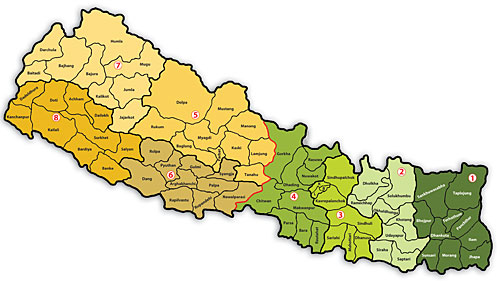 |
Federalism won't eliminate social injustice in Nepal, despite claims to the contrary. For instance, it will require sound policies, not just autonomous provinces, to ensure that women are adequately represented in the legislature. Plus, federalism is tricky in a country as geographically and socially diverse as Nepal, so will require an intelligent assessment of the interactions between economic, bio-physical and social variables. Nonetheless, if the important issues are given due attention and viewed through a geographic perspective, federalism could work wonders.
Provincial boundaries ought to represent the realities of bio-physical, social, economic and historical geography. Provinces will more likely prosper if they span, and enable interaction between the Himalayan, Mid-hill and Tarai regions, with resources shared equitably. Provinces should also be demarcated in a way that accounts for the economic predominance of particular resources in particular regions, like farmland in the Tarai.
The shape and size of these provinces are important but rarely discussed. Provinces need their capitals to assume responsibility for the provision of province-level services. Like it or not, capitals are power centres, and exclusion, poor access and deprivation increase in proportion to distance from these centres. Elongated provinces run the risk of estranging their populations. It would be too embarrassing to have to traverse the capital of another province to get to your own capital. Provinces should be shaped and sized in a way that their capitals are not too far from large sections of their populations.
Rights and responsibilities should be sensibly distributed between the centre, provinces, districts and villages. One possibility is to let the centre handle defense, the minting of currency, international relations, development and natural resources; give the districts and villages greater authority over development; and split political and administrative authority between provinces and the central state.
The names of provinces have drawn far more attention, which may not be undeserved, since they have enormous consequences for inter-caste relations. The names will inevitable rankle minority populations within provinces and, since these names will remain even as people migrate in and out, potentially future majorities too.
We should also remember that we want these provinces to last many generations, so we should demarcate them with an eye on future trends: newer generations will have different preferences, migration and inter-caste marriage will become more popular, and there's a looming youth bulge.
Whatever form federalism finally takes, it won't last long without grassroots support. We should start at the local level, informing individuals of federalism's pros and cons, begin with viable development units based on human geography and economic linkages, and bring these together into viable regions or provinces.
If all these issues are properly understood, then federalism can go a long way in overcoming social injustice.
Bhim Prasad Subedi is a Professor of geography at Tribhuvan University. This article is a summary of a presentation at the Centre for Constitutional Dialogue.
READ ALSO:
Constitution 2010, previous articles on the constitution from Nepali Times archives


